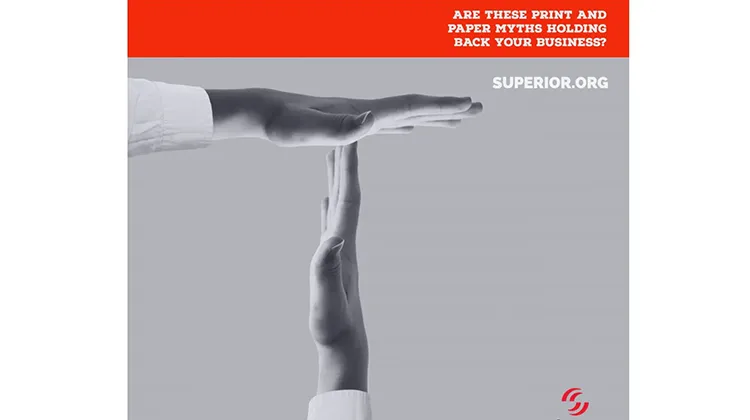Don’t Let These Myths Lead You into Business Missteps
If you run a business, you face plenty of obstacles: costs, competition, and staffing issues to name a few. And that’s fair; marketplace realities (and how you respond to them) dictate the success of any business. But frankly, one thing isn’t fair: the misconceptions some people hold about the use of print and paper. These misconceptions could hold back your business and even worse, losing your customers. Printing services go a long way in satisfying customers and promoting your business. And once you know the facts, you can use print and paper freely without worrying about harm to the environment.
Those trying to capitalize on digital trends often misrepresent the sustainability of print. But the truth knocks the wheels off that bandwagon in a hurry. Today I’d like to arm you with real information that should free you up to run your business with maximum efficiency and success, using paper wherever you like.
Hit or Myth #1: “Going Paperless Saves Forests.”
VERDICT: MYTH
You’ve seen the “save a tree” mantra used in emails and other places. It sounds logical until you learn the facts:
- There are 20% more trees in the U.S. today than there were on the first Earth Day, celebrated in 1970.
- The best protection for our forests is a stable market for paper and other wood products. Without that, they are vulnerable to being sold for development and other purposes.
- Each year forests in the U.S. and Canada grow significantly more wood than is harvested.
The bottom line is that North American forests are a renewable resource, continuously being replenished. If “going paperless” impacts forest survival, it is likely to be a negative one.
Hit or Myth #2: “Electronic Communication is More Environmentally Friendly.”
VERDICT: MYTH
Not infrequently, when businesses announce they are going to all-electronic invoice and statement processing, they talk about sustainability and protecting the environment. But there is plenty they don’t say (if they even know). Electronic communications have a huge environmental impact that is seldom publicized.
- The manufacturing process for the world’s two billion smartphones, one billion computers and many millions more servers and other connected devices uses significant amounts of fossil fuels.
- The Information and Communications Technology (ICT) sector is projected to contribute up to 14 percent of greenhouse gases by 2040. That dwarfs the one percent contributed by the pulp, paper and print sector.
- Electricity used to power electronic devices in individual homes is equivalent to the output of three large coal-fired power plants. The CO2 emissions are the equivalent of 1.1 million automobiles annually.
- More than 100 North American companies have already removed or revised their environmental message supporting digital communications.
I’m not trying to throw electronics “under the bus” here. They are valuable and we certainly use them, too. But when someone suggests that paper and printing are damaging the environment, remember that, first, you are only getting half the story. And second, the half you are getting is simply not accurate.
Hit or Myth #3: “Digital Is Always the Preferred Form of Communication.”
VERDICT: MYTH
I won’t deny that people today are constantly on their smartphones, often when they shouldn’t be (like when driving or playing with their kids). But if you assume that means “everybody” prefers electronic communication to print, you would be wrong. I touched on this one in a recent post, where I showed how that assumption could lead to a bad business decision.
What people want most today is a choice. Some do prefer electronic communications, but fewer than you might think. And almost all consumers resent having no say in the matter. Check out these research results:
- Almost 70 percent of consumers in the U.S. find it easier to track expenses and manage finances when the information was printed on paper.
- Nearly two-thirds preferred receiving bills and financial statements through a combination of both paper and online resources
- A very interesting one: 89 percent of adult Americans believe that “moving customers to online-only documents disadvantages groups, such as the elderly, disabled, low income, and poorly educated.
- And what about those technology-loving students and young people? Nearly all expressed a preference for paper, most saying they performed better when reading on paper than on a screen. (I’ve seen other research that shows they do better when taking notes on paper vs. a computer or tablet, as well.)
Many consumers remain most comfortable seeing things in print, and nearly all of them want to be able to access accounts and statements both ways. It would be foolish to rush into a decision that most of your customers will resent, simply because some expert says it’s the future. Personally, I’d prefer a future with lots of customers in it.
It’s No Myth: Call Superior for Proven Printing Services
Learn more about the truth behind these busted myths. And learn how our printing services can help your business gain customers. That’s been our mission for nearly 100 years now. We do it through print, promotional items, sales enablement tools and more. We have the processes and people to ensure that your business benefits from all the good things print and paper have to offer.
Our ISO certification is no myth. Neither is the “Best of Print and Digital” award we’ve won for two straight years, thanks to our customers. Contact Superior today to see how your business can benefit from the magnificent possibilities of print.



